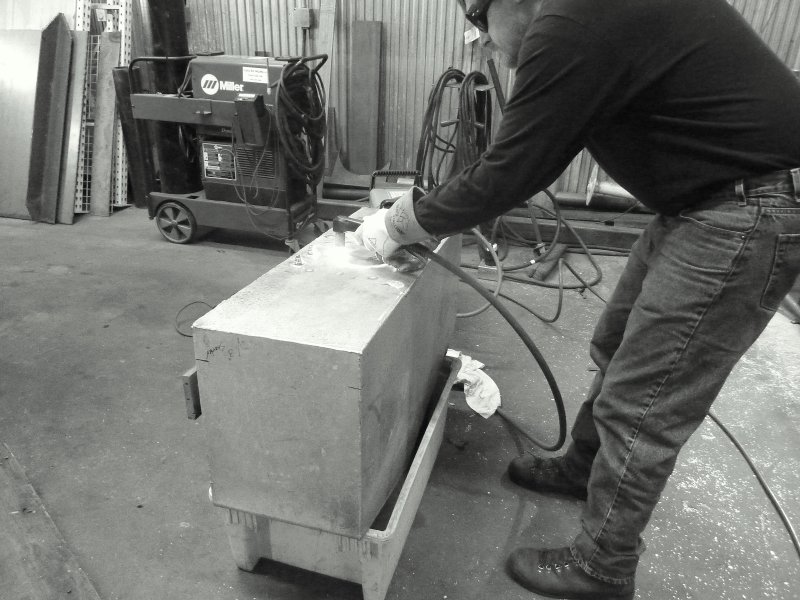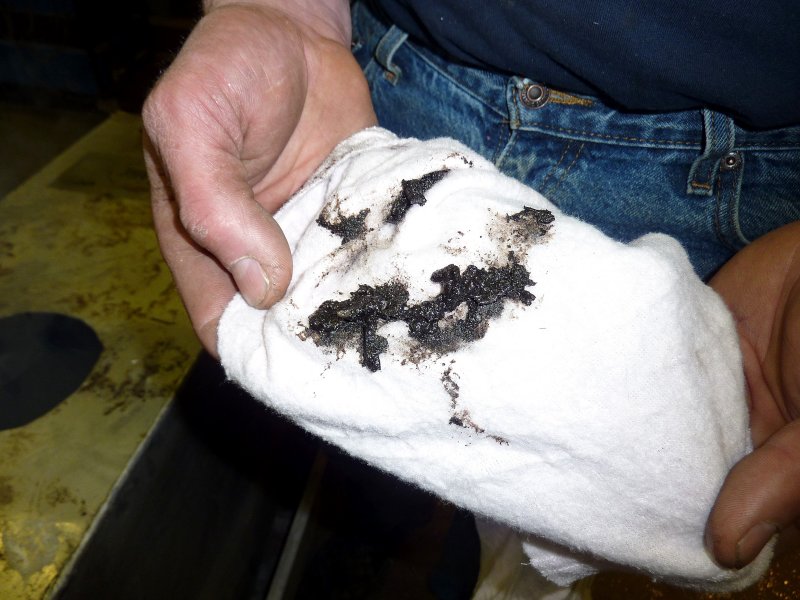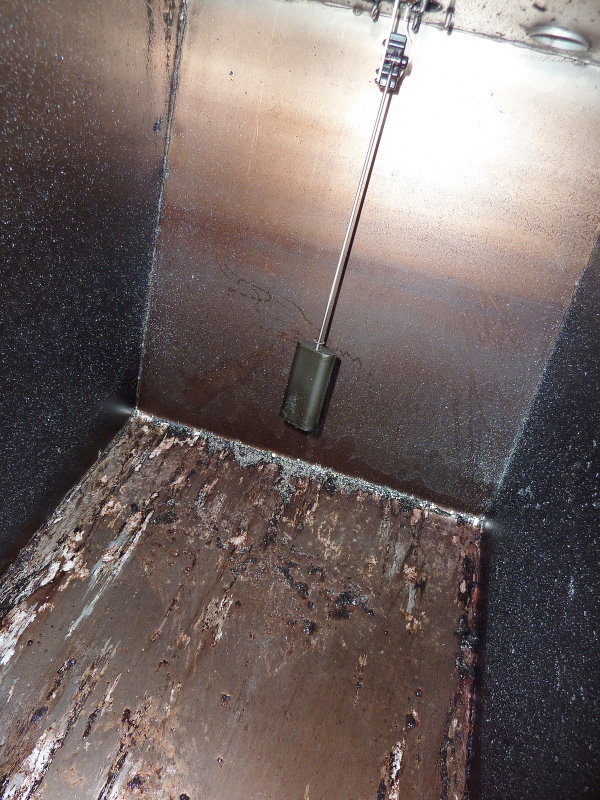As promised, for those who dropped in on my post from a few weeks ago, I cut open my 31 year old fuel tank to examine the insides.
This boat & tank has had three owners. The original owner had her from 1979 until 1982, then the PO, a friend of mine, bought her and owned her until we bought her in 2007. The PO to me claims to have always used a biocide and in 1999 switched to a biocide and Sol Tron. At the time Sol Tron was not available in the US but he heard of it bought a case of it while off cruising. He claims to have used the two religiously and never had a fuel filter issue.
To his credit I have also never plugged a fuel filter either. Of course I am just now finding out that I was just plain lucky or that the Racor turbine filters ARE everything they are cracked up to be? I continued to use Star Tron, the marketing name for the US, since purchase and have even shocked the tank twice at the suggestion of the manufacturer. It basically did squat.
The claims:
Sludge / Growth:
To make a long story short I am shocked at how dirty this tank was after the "treatment" it has received. IMHO Sol Tron / Star Tron does nothing to "clean the fuel delivery system". Of course I don't know how bad it was before it began life in this tank prior to 11 years ago but if it looks like this now then it is awfully slow at cleaning the fuel delivery system.
It should also be noted that this tank was "polished" in 2003 at the time they installed the new engine. It is clear to see that with the baffles they could have only ever polished the first chamber. Even then there is NO WAY you are getting the algae and growth off the tank walls..
Grade: I give Sol Tron / Star Tron a "F" in the "cleans the fuel delivery system" department.
Water:
The tank, at 31 years old, had ZERO water in it. I was rather surprised by this to be honest. I am a believer in condensation, just not boat tank condensation and I guess this vindicates my belief. Some winters I try and leave it empty, and others, like this one, it sits at just under 1/4 full. Still, zero water in the tank and I NEVER "top it off"...
Grade: I give Sol Tron / Star Tron a hesitant "B" rating for water dispersion. I say hesitant because at 31 years old it should have been bound to have some water in it but did not. As we say in Maine "hahd tellin' nawt knowin'".... I change my o-rings yearly so I know water is not getting in through there but also not from the dreaded "condensation"..
Cutting Hole In The Tank With A Plasma Cutter:

The First Sampling From the Tank Walls:

The Tank Inside:

Why My Fuel Gauge Was Never Accurate:

This is the last bit of fuel from the tank. It is filthy because I sucked it off the bottom with a turkey baster. The metallic flakes at the bottom are just that, pieces of aluminum from the plasma cutter. The key here is no water! The fuel in the Racor bowl NEVER looked this bad, perhaps because the tank pick up was about 2" off the bottom of the tank.

Despite it's utter failure to "clean" my tank I may continue to use Star Tron on the new tank but the new tank will have a dedicated fuel polishing system from day one that will turn the tank over twice per hour. I do think much of these treatments and the claims are snake oil but some things may be true.
All in all they hype about this stuff "cleaning" your fuel system is borderline criminal false claims IMHO. After all, it had 11 solid years to clean this tank, but failed miserably.. Perhaps in another 31 years I will be able to report on how well Star Tron, in conjunction with a dedicated fuel polishing system, works....
With all that said I still believe my engine runs cleaner, less smoke, and this motor, @ 3000 hours of use, has never had an injector rebuild or replacement nor any fuel system issue.
If you want to buy this stuff to clean your tank, don't, but if you want to buy it to do other things it MAY be okay....
This boat & tank has had three owners. The original owner had her from 1979 until 1982, then the PO, a friend of mine, bought her and owned her until we bought her in 2007. The PO to me claims to have always used a biocide and in 1999 switched to a biocide and Sol Tron. At the time Sol Tron was not available in the US but he heard of it bought a case of it while off cruising. He claims to have used the two religiously and never had a fuel filter issue.
To his credit I have also never plugged a fuel filter either. Of course I am just now finding out that I was just plain lucky or that the Racor turbine filters ARE everything they are cracked up to be? I continued to use Star Tron, the marketing name for the US, since purchase and have even shocked the tank twice at the suggestion of the manufacturer. It basically did squat.
The claims:
Star Tron said:This same enzyme package, cleans the fuel delivery system and combustion chambers, stabilizes fuel chemistry and reduces engine emissions.
The enzymes contained in Star Tron can actually "repair" old and fouled diesel fuel by increasing cetane and eliminating sludge, varnish & water.
Sludge / Growth:
To make a long story short I am shocked at how dirty this tank was after the "treatment" it has received. IMHO Sol Tron / Star Tron does nothing to "clean the fuel delivery system". Of course I don't know how bad it was before it began life in this tank prior to 11 years ago but if it looks like this now then it is awfully slow at cleaning the fuel delivery system.
It should also be noted that this tank was "polished" in 2003 at the time they installed the new engine. It is clear to see that with the baffles they could have only ever polished the first chamber. Even then there is NO WAY you are getting the algae and growth off the tank walls..
Grade: I give Sol Tron / Star Tron a "F" in the "cleans the fuel delivery system" department.
Water:
The tank, at 31 years old, had ZERO water in it. I was rather surprised by this to be honest. I am a believer in condensation, just not boat tank condensation and I guess this vindicates my belief. Some winters I try and leave it empty, and others, like this one, it sits at just under 1/4 full. Still, zero water in the tank and I NEVER "top it off"...
Grade: I give Sol Tron / Star Tron a hesitant "B" rating for water dispersion. I say hesitant because at 31 years old it should have been bound to have some water in it but did not. As we say in Maine "hahd tellin' nawt knowin'".... I change my o-rings yearly so I know water is not getting in through there but also not from the dreaded "condensation"..
Cutting Hole In The Tank With A Plasma Cutter:

The First Sampling From the Tank Walls:

The Tank Inside:

Why My Fuel Gauge Was Never Accurate:

This is the last bit of fuel from the tank. It is filthy because I sucked it off the bottom with a turkey baster. The metallic flakes at the bottom are just that, pieces of aluminum from the plasma cutter. The key here is no water! The fuel in the Racor bowl NEVER looked this bad, perhaps because the tank pick up was about 2" off the bottom of the tank.

Despite it's utter failure to "clean" my tank I may continue to use Star Tron on the new tank but the new tank will have a dedicated fuel polishing system from day one that will turn the tank over twice per hour. I do think much of these treatments and the claims are snake oil but some things may be true.
All in all they hype about this stuff "cleaning" your fuel system is borderline criminal false claims IMHO. After all, it had 11 solid years to clean this tank, but failed miserably.. Perhaps in another 31 years I will be able to report on how well Star Tron, in conjunction with a dedicated fuel polishing system, works....
With all that said I still believe my engine runs cleaner, less smoke, and this motor, @ 3000 hours of use, has never had an injector rebuild or replacement nor any fuel system issue.
If you want to buy this stuff to clean your tank, don't, but if you want to buy it to do other things it MAY be okay....
